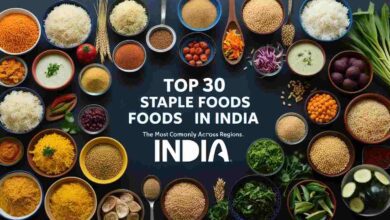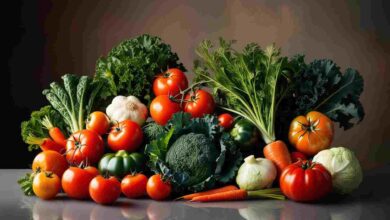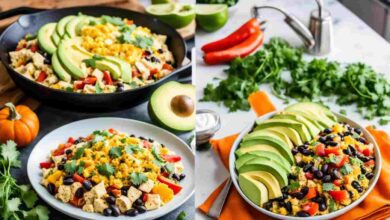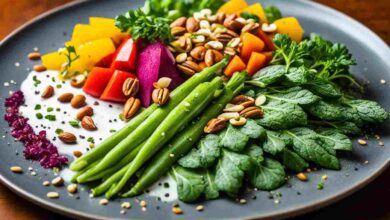How to make vegetarian food more filling
"Tips and Tricks for Creating Satisfying Plant-Based Meals"
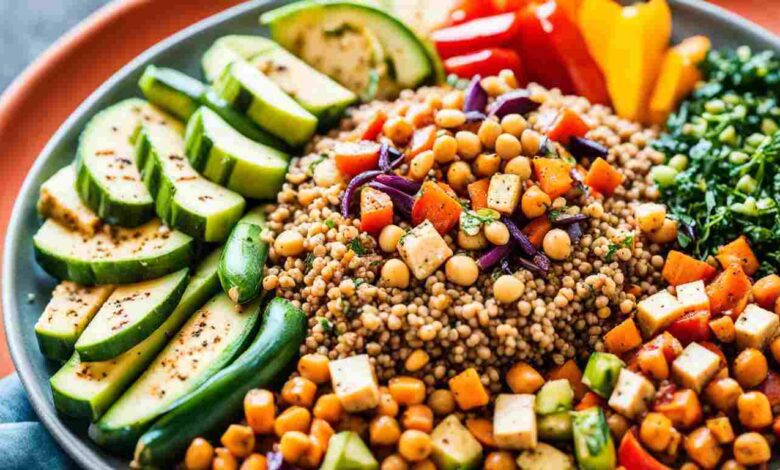
Vegetarian food has gained immense popularity in recent years, reflecting a growing interest in healthier eating habits and sustainable living. For those exploring plant-based cuisine, creating satisfying and filling meals is essential. This blog post will guide you through various strategies to enhance the heartiness of your veggie dishes, ensuring that your vegetarian fare is not only nutritious but also delightful. From hearty plant-based dishes to innovative meatless meals, we’ll explore how to transform your herbivorous diet into a fulfilling experience. Whether you’re looking for new meatless recipes or simply wish to elevate your veggie plates, this guide will provide the insights you need to make your vegetarian cuisine truly satisfying. Join us as we delve into the world of filling meat-free meals and discover the best ways to enjoy delicious veggie fare.
Key Takeaways
- Incorporate more whole foods like fruits, vegetables, nuts, seeds, and grains to enhance satiety1
- Include fiber, fluid, and protein in meals to boost the feeling of fullness1
- Choose nutrient-dense whole grains like farro that are loaded with fiber1
- Add protein-rich legumes like lentils and beans to meals for increased satiety2
- Experiment with plant-based protein sources like tofu and tempeh2
Understand the Importance of Balancing Nutrients
When you follow a vegetarian diet, it’s key to get enough protein, fiber, and healthy fats. These nutrients together help you feel full and satisfied3. Protein keeps your blood sugar stable and helps your muscles recover. Fiber and healthy fats slow down digestion, making you feel full for longer3. But eating too many processed carbs can cause blood sugar spikes and make you hungry again quickly3.
Combine Protein, Fiber, and Healthy Fats
To make tasty plant-based meals, mix different protein sources like pulses, tofu, tempeh, and mycoprotein3. Add whole grains, vegetables, and healthy fats like nuts, seeds, and avocado for a balanced diet3. This mix will keep you full and healthy for a longer time.
Limit Processed Carbohydrates
Carbs are vital, but it’s smart to cut down on processed and refined ones, like white bread and sugary snacks3. Choose nutrient-dense whole grains, like quinoa, brown rice, and oats instead. They give you steady energy and more fiber and vitamins3.
“A well-planned vegetarian diet can meet the nutritional needs of individuals of all ages, including pregnant or breastfeeding women.”4
By focusing on protein, fiber, and healthy fats, you can make vegetarian meals that keep you full and energized all day3. The secret to a great vegetarian diet is eating whole, unprocessed foods that give you lots of important nutrients435.
Incorporate Whole Grains and Legumes
Whole grains and legumes are key to making vegetarian meals satisfying. They are packed with complex carbs, fiber, and plant-based protein. This combo helps you stay full and energized6.
Choose Nutrient-Dense Whole Grains
Go for whole grains like quinoa, farro, barley, and steel-cut oats for more energy. These grains are full of fiber, complex carbs, and vitamins and minerals. They support your health6.
Add Protein-Rich Legumes to Meals
Legumes, including beans, lentils, and chickpeas, are very filling thanks to their protein and fiber7. Adding these legumes to your meals keeps you full longer. This can help with weight management67.
Enjoy a hearty lentil soup, a fiber-rich bean burrito, or a quinoa salad. Mixing whole grains and legumes makes vegetarian dishes satisfying and energizing67.
“Incorporating whole grains and legumes into your meals can help you feel fuller for longer and support overall health.”
A balanced vegetarian diet with whole grains and legumes is nourishing and satisfying67.
Experiment with Plant-Based Protein Sources
For a more filling vegetarian diet, it’s key to explore plant-based protein options. Tofu and tempeh, from soybeans, are great for many dishes8. They give you 12-20 grams of protein per 3.5-ounce serving8. Meat alternatives like Beyond Sausage and Field Roast also offer a lot of protein and texture9. Most vegetarians and vegans get way more protein than they need, about 70 grams a day9.
Try Tofu, Tempeh, and Meat Alternatives
Adding these plant-based protein sources to your meals makes them more filling and nutritious. Tofu and tempeh can be seasoned or cooked in many ways. Meat alternatives like burgers and sausages add protein and texture to your meals8. Seitan, a wheat-based protein, has about 25 grams of protein per 3.5-ounce serving, making it a top plant-based protein choice8.
By trying these plant-based protein options, you can make your vegetarian meals more filling and nutritious9. For most people, 10-15% of daily calories from protein is enough, even if you’re active9.
“High protein intake, particularly from animal sources, was linked to an increased risk of developing type 2 diabetes in a cohort study from 2014.”9
Using a mix of plant-based protein sources in your diet helps you get enough protein and supports your health9. The U.S. government suggests 0.8 grams of protein per kilogram of body weight, so about 50 grams for a 140-pound person on a 2,000 calorie diet9.
| Plant-Based Protein Source | Protein Content (per 3.5 oz/1 cup cooked) |
|---|---|
| Seitan | 25 grams |
| Tofu, Tempeh, Edamame | 12-20 grams |
| Lentils | 18 grams (per cooked cup) |
| Beans | 15 grams (per cooked cup) |
| Nutritional Yeast | 8 grams (per 1/2 oz) |
| Spelt, Teff | 10-11 grams (per cooked cup) |
| Hemp Seeds | 9 grams (per 3 tbsp) |
| Green Peas | 9 grams (per cooked cup) |
| Spirulina | 8 grams (per 2 tbsp) |
| Amaranth, Quinoa | 8-9 grams (per cooked cup) |
| Ezekiel Bread | 8 grams (per 2 slices) |
| Soy Milk | 6 grams (per cup) |
| Oats | 5 grams (per 1/2 cup dry) |
This table shows the wide variety of plant-based protein sources and their protein amounts. It helps you pick the best options for filling and nutritious vegetarian meals8910.
Maximize Fiber Intake from Vegetables and Fruits
For a more filling vegetarian diet, eat a lot of fiber-rich vegetables and fruits. These foods are full of nutrients and give your body the fiber it needs11.
Great options include artichokes, broccoli, Brussels sprouts, berries, apples, and pears. These foods make you feel full and happy, helping you follow a plant-based diet11.
Research says Americans eat only about 15 grams of fiber a day, half of what we should1112. The Academy of Nutrition and Dietetics suggests eating 14 grams of fiber for every 1,000 calories13.
To get more fiber, add these foods to your meals and snacks:
- A medium-sized, raw pear has 5.5 grams of fiber11.
- One cup of raw avocado gives you 10 grams of fiber11.
- One cup of raw oats has 16.5 grams of fiber11.
- A medium-sized, raw apple has 4.4 grams of fiber11.
- One cup of cooked lentils provides 13.1 grams of fiber11.
- One cup of cooked kidney beans offers 12.2 grams of fiber11.
- One cup of cooked split peas contains 16.3 grams of fiber11.
- One cup of air-popped popcorn has 1.15 grams of fiber11.
Make fiber-rich vegetables and fruits a big part of your vegetarian diet. This way, you’ll get the nutrients you need to feel satisfied and full all day111213.
“Incorporating a variety of fiber-rich produce into your meals and snacks can help promote feelings of fullness and satisfaction.”
Utilize Healthy Fats for Satiety
Healthy fats are key to making vegetarian meals satisfying. Fats in nuts, seeds, and avocados help you feel full and give you energy. These fats are slow to break down, so they keep you feeling satisfied for a long time14.
Include Nuts, Seeds, and Avocados
Add moderate amounts of nutrient-dense fat sources like nuts, seeds, and avocados to your meals and snacks15. Medium-chain triacylglycerols (MCT) make you feel more full than long-chain triacylglycerols (LCT) in both animals and humans14. Polyunsaturated fatty acids (PUFA) and monounsaturated fatty acids (MUFA) help control appetite and eating in overweight people14.
Avocados are mostly about 80% fat, making them rich in healthy fats15. Eating one avocado daily for 5 weeks improved cholesterol levels in a study with 45 men and women15. Nuts are also packed with healthy fats and fiber, which can lower the risk of obesity and heart disease15.
Adding these satisfying fats to your vegetarian diet means you can enjoy filling and nutritious meals. These meals will keep you feeling satisfied and full of energy all day1415.
Practice Mindful Eating Habits
Mindful eating can make your vegetarian meals more satisfying and fun. By eating slowly, enjoying each bite, and listening to your body, you can make meals better16.
Slow Down and Savor Your Meals
Slowing down is key to mindful eating. Try eating with your non-dominant hand or chew each bite 30 times16. This helps you enjoy the taste and feel of your food more. Avoid using screens or doing other things while you eat16.
Mindful eating also helps you pay attention to when you’re hungry or full. It stops you from eating because you’re stressed or bored16. This can stop you from eating too much and helps you have a better relationship with food.
Eating with others can make you more mindful. It makes you more present, lifts your mood, and helps you sleep better16. Having a mindful kitchen can also lead to healthier meals and eating habits16.
Mindful eating is just as good for losing weight as other diets17. It can stop unhealthy eating habits, like eating because you’re stressed or bored17. It can also help prevent and lessen binge eating17.
Adding mindful eating to your vegetarian life makes meals more enjoyable and helps you have a better relationship with food. Slow down, enjoy each bite, and listen to your body for a fulfilling meal.
Vegetarian Food for Breakfast
Starting your day with a vegetarian breakfast can set the tone for the rest of your meals. A bowl of oatmeal with nut butter and fresh fruit is a great choice. It combines complex carbs, protein, and healthy fats for energy and fullness18.
Oatmeal with Nut Butter and Fruit
Oatmeal is a nutritious and versatile breakfast choice. Add creamy nut butter like almond or peanut butter for extra protein and healthy fats18. Then, top it off with fresh or frozen fruit for vitamins, minerals, and fiber18.
This plant-based breakfast is tasty and keeps you energized and focused. The fiber in oats, along with protein and healthy fats from nut butter and fruit, makes a balanced meal. It leaves you feeling satisfied and ready for the day18.
| Ingredient | Quantity |
|---|---|
| Olive oil | ¼ cup19 |
| Frozen shredded hash browns or 2 medium russet potatoes | 5 cups (1 pound)19 |
| Chili powder | 1 teaspoon19 |
| Garlic powder | 1 teaspoon19 |
| Cumin | 1 tablespoon19 |
| Fennel seeds | ¼ teaspoon19 |
| Salsa and fresh cilantro (optional) | – |
Vegetarian breakfasts like oatmeal with nut butter and fruit are nutritious and satisfying. They keep you energized and focused in the morning18.
“Vegetarian breakfasts offer good amounts of nutrition while being appealing to a wide array of individuals.”18
Satisfying Vegetarian Lunch Options
Lentil or bean-based soups and salads make great plant-based lunches. They are filling and keep you energized. The protein and fiber from legumes, along with the broth or greens, make a meal that’s both nourishing and satisfying20.
Lentil or Bean-Based Soups and Salads
Lentil-based soups like a hearty lentil stew or a zesty red lentil curry are perfect for a vegetarian lunch. They’re high in protein and fiber, making you feel full and satisfied21. Bean-based salads, such as a Mediterranean chickpea salad or a black bean and quinoa salad, are tasty and full of nutrients20.
These meals are not only nutritious but also easy to make ahead of time. They’re great for busy workdays20. Plus, you can customize them to your taste, trying new flavors and ingredients21.
“Vegetarian lunches don’t have to be boring or unsatisfying. With the right combination of nutrients, you can create plant-based meals that are both delicious and filling.”
Adding lentil or bean-based soups and salads to your vegetarian lunch routine nourishes your body. You’ll enjoy a satisfying midday meal20. Make sure to include a variety of plant-based proteins, fibers, and healthy fats for a well-rounded lunch21.
Hearty Vegetarian Dinner Ideas
Looking for satisfying vegetarian dinners? Consider stuffed sweet potatoes and vegetable and grain-based stir-fries. These meals are filling and packed with plant power.
Stuffed Sweet Potatoes with Beans and Veggies
Stuffed sweet potatoes are a tasty and healthy choice for dinner22. Fill them with beans, veggies, and avocado for a meal full of protein and fiber. The sweet potato’s natural taste goes well with savory fillings, making it a fulfilling dish.
Vegetable and Grain-Based Stir-Fries
For a quick and nutritious dinner, try a stir-fry with various veggies and grains23. These meals are ready in under 30 minutes, perfect for busy nights. Add ingredients like mushrooms, bell peppers, broccoli, and quinoa for a meal that’s both filling and plant-based.
| Vegetarian Dinner Idea | Key Ingredients | Cooking Method | Nutrition Benefits |
|---|---|---|---|
| Stuffed Sweet Potatoes | Sweet potatoes, beans, vegetables, avocado | Baking, sautéing | High in fiber, protein, and healthy fats |
| Vegetable and Grain Stir-Fry | Mushrooms, bell peppers, broccoli, quinoa, farro | Stir-frying | Nutrient-dense, high in fiber and complex carbs |
These vegetarian dinner ideas offer satisfying, plant-based meals that keep you full and energized222324.
“Adding more plant-based foods to your diet is both tasty and healthy. Try vegetarian dinners like stuffed sweet potatoes and grain-based stir-fries for a meal that’s filling and good for you.”
Snack Ideas for Sustained Energy
Choosing the right vegetarian snacks is key for lasting energy and satisfaction. Trail mixes with nuts and seeds25 are a great pick. They’re packed with protein, healthy fats, and fiber from plants. This combo keeps you fueled and full between meals25.
Other good snack ideas include fresh fruit with nut butter, hummus with raw veggies, and yogurt with berries. These snacks balance nutrients to keep your energy steady and prevent afternoon crashes26.
- RX Bars offer 12 grams of protein, more than many plant-based snack bars25.
- Nativas Organic Superfood Power Snacks have only one gram of sugar and are low in calories and protein, perfect for a light snack25.
- Food to Live Organic Trail Mix is organic and a convenient, filling snack, but it’s lower in protein25.
- Paleovalley Turkey Sticks are a protein-rich snack made from pasture-raised turkey, offering a sustainable choice25.
- Wild Planet Wild Canned Tuna is high in protein and a versatile snack, made with sustainably caught tuna25.
- SkinnyDipped Dark Chocolate Cocoa Almonds have only 2 grams of sugar and are gluten-free, making them a sweet, healthy option25.
- Spread the Love Naked Peanut Butter Packets have no added sugar and are organic, perfect for a plant-based protein boost25.
- Brami Lupini Snacking Beans are full of fiber and protein, with no added sugar for a healthy snack25.
- Good Culture Cottage Cheese gives you 19 grams of protein, great for a filling snack25.
- Kettle and Fire Soup offers nutrient-rich options made with bone broth, a satisfying and easy-to-carry savory snack25.
These vegetarian snacks are packed with protein, fiber, and healthy fats. They help you stay full and energized, giving you a steady flow of nutrition all day2526.
Meal Planning and Preparation Tips
Effective meal planning and meal prep can change how you make vegetarian meals. Spend some time each week to plan meals, make a grocery list, and prep things like roasted veggies or cooked grains27. Having these ready can make putting together vegetarian dishes easy on busy nights27. It also helps you avoid unhealthy, quick foods27.
Think about making vegetarian meal plans that match your likes and life27. These plans can be simple dinners or meals with lots of protein, Mediterranean flavors, or be easy on the wallet27. You’ll find recipes like Grilled Gnocchi with Summer Vegetables and lentil salad27. Prep time can be short or take a whole week, depending on what you can do27.
Eating more plant-based foods is good for your health28. People eating these diets often have fewer heart problems, lower cancer risk, and are less likely to get diabetes28. A vegetarian diet for losing weight can be about 1,500 calories a day, helping you lose 1 pound a week28. It includes many plant-based proteins like beans, lentils, nuts, and soy, making sure you get all the nutrients you need28.
To improve your vegetarian meal planning and preparation, try using a variety of ingredients and cooking methods29. The recipes offer a mix of vegetables, grains, and plant-based proteins, showing off flavors from around the world29. You’ll find baked, stir-fried, and grilled dishes, even tofu-based ones, for every taste29. Many recipes are quick, ready in 30 minutes or less, ideal for busy evenings29.
Planning and prepping your vegetarian meals ahead can lead to tasty, healthy, and satisfying dishes. With some planning and creativity, making vegetarian meal planning and prep easy is possible.
“Meal planning and preparation are game-changers for creating tasty, filling vegetarian meals on a regular basis.”
Conclusion
Making your vegetarian diet more filling and satisfying takes a full approach. Focus on balancing protein, fiber, and healthy fats. Also, limit processed carbohydrates. This way, you get meals that are both nutritious and satisfying30.
Add whole grains, legumes, and various plant-based protein sources to your meals. This gives you a steady energy flow and a feeling of fullness. Also, eat more fiber-rich vegetables and fruits. Use healthy fats like nuts, seeds, and avocados to make your vegetarian dishes more satisfying31.
Practice mindful eating habits by eating slowly and enjoying your food. Try different combinations to see what you like best. Use these vegetarian diet tips in your daily plant-based eating routine. With these tips, you can make your vegetarian meals more fulfilling and nutritious32.
FAQ
What is the most famous vegetarian dish?
There isn’t just one “most famous” vegetarian dish. Vegetarian cuisine offers many tasty and popular options from all over the world. You might know dishes like vegetable curries, lentil stews, bean chilis, veggie stir-fries, and plant-based burgers.
What should I serve vegetarian guests for dinner?
For vegetarian guests, consider dishes like stuffed sweet potatoes, vegetable and tofu stir-fries, lentil or bean soups, and pasta dishes loaded with veggies. Make sure to include a mix of protein, fiber, and healthy fats to keep them full and happy.
What are the most filling vegetarian foods?
Whole grains like quinoa, farro, and oats, and legumes such as beans, lentils, and chickpeas are very filling. Vegetables like broccoli, Brussels sprouts, and artichokes, along with fruits like apples and berries, also help you feel full. Adding healthy fats from nuts, seeds, and avocados makes vegetarian meals even more satisfying.
Can vegetarians eat pizza?
Absolutely, vegetarians can enjoy pizza! Many pizzerias offer options without meat, using vegetable toppings, plant-based cheese, and soy-based “pepperoni” or sausage. You can also make your own pizza with vegetable sauces, plant-based cheese, and various veggie toppings.
How do vegetarians get protein?
Vegetarians get protein from many plant-based foods. These include legumes like beans, lentils, and peas, soy products like tofu and tempeh, nuts and seeds, whole grains, and some veggies. By eating a mix of these, vegetarians can easily get enough protein without animal products.
Source Links
- 10 tips for feeling full on a vegetarian diet
- 11 Vegetarian Meals That Are Just As Filling As Meat
- The vegetarian diet
- Vegetarian diet: How to get the best nutrition
- How to Maintain a Balanced Diet as a Vegetarian or Vegan
- Whole-Foods, Plant-Based Diet: A Detailed Beginner’s Guide
- Legumes: Health Benefits and Culinary Approaches to Increase Intake
- The 18 Best Protein Sources for Vegans and Vegetarians
- The No-B.S. Guide to Vegan Protein
- Dietary Protein and Amino Acids in Vegetarian Diets—A Review
- 22 High Fiber Foods You Should Eat
- Increasing Fiber Intake
- How much fiber is found in common foods?
- Fats and Satiety – Fat Detection
- 9 High Fat Foods That Are Actually Super Healthy
- 6 Ways to Practice Mindful Eating
- Mindful Eating 101 — A Beginner’s Guide
- What Does a Vegetarian Eat for Breakfast? 10 Healthy Ideas
- 25 Vegetarian Breakfast Ideas
- 35 Best Vegetarian Lunch Ideas – The Plant Based School
- 28 High-Protein Vegetarian Lunch Ideas
- 65+ Best Vegetarian Dinner Recipes
- 101 Vegetarian Dinner Recipes We’ve Got on Repeat
- Vegetarian dinner recipes
- 19 Healthy and Energizing Snacks
- How to Build Balanced Plant Based Snacks – Plant Based RD
- Here Are 11 Weeks’ Worth of Easy Vegetarian Meal Plans
- Vegetarian Diet Plan for Beginners
- 30-Day Vegetarian Dinner Meal Plan
- Vegetarian Diet: A Boon or Bane for Health?
- Vegetarian Diet: An Overview through the Perspective of Quality of Life Domains
- Vegetarian and vegan diets: benefits and drawbacks

